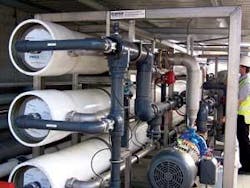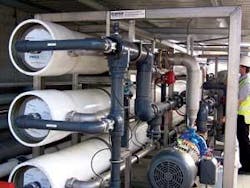Anatomy of Large Diameter Membranes
By Anthony Day, Antonia von Gottberg, Rick Lesan and Paul Lambert
In recent years, increasing the diameter of spiral elements has been studied as a method of lowering the cost of membrane treatment. Previously presented technical papers have shown that the installed cost of a reverse osmosis (RO) plant can be reduced by up to 27 percent using larger diameter elements (Yun et al. 2002, Bartels et al. 2005). Large diameter elements provide savings in footprint and building costs, as well as savings in the number of connections, to reduce the installed cost of a brackish water RO or nanofiltration (NF) system.
Koch Membrane Systems. (KMS) has developed large diameter RO elements that are 18” in diameter and 61” in length, called a MegaMagnum® element. The 18” diameter element offers a factor of five scaling in membrane area over the traditional 8” platform, and up to 30 percent gain in area over a 16” nominal diameter with only a two inch increase in center-to-center spacing.
All spiral elements are comprised of multiple leaf units. Even the 4” cartridge is equipped with four leaf units. As the diameter of the element increases, a corresponding number of leaf units must be added. If the leaf units are all of the same length and materials, they should all have the same efficiency. Due to their identical efficiency, spiral elements can be reliably extrapolated from a small diameter up to a larger diameter. An individual leaf does not know whether it is part of a 4”, 8” or 18” element. In the case of the 18” nominal element, over 90 leaf units are required to construct an element with the same efficiency as a typical 8” element. The challenge then becomes one of assembling multiple leaf units into one package.
The core tube serves as a center backbone around which the spiral element is wrapped. This tube is also the means by which permeate leaves the element. The inside diameter (ID) of the tube must be large enough that there are no significant pressure losses that might impact the element efficiency. In the current 18” x 61” design, a 3.5” core tube is used, and the final exit velocity in the core tube for five elements in a series in a housing operating at an average flux of 15 gfd is 6.3 ft/s. This is 65 percent of that of a standard 8”x40” element, so permeate pressure losses are lower than those for 8” elements.
The 18” diameter MegaMagnum element has an external sleeve design for coupling. The sealing compression is provided by the dimensions of the coupling and the core tube, and does not rely on any camming action or twisting of the element seal plates. Because the coupling is external to the core tube, a very large cross-section O-ring can be used without restricting the flow capacity of the inside of the core tube.
The coupling unit is locked within a cavity that is an integral part of the two element seal plates. The elements are joined together at the outer surface of the seal plates by several fastener keys. As the seal plates are locked together and the coupling is restrained within the internal pocket formed between the two seal plates, there can be no movement of the O-rings relative to the element, no matter how much dynamic movement of the elements occurs.
By using the same materials of construction as used with standard size elements, performance of the element is predictable. For example, differential pressure as a function of superficial velocity is the same for 8” and 18” elements of similar length. However, one aspect of designing a large diameter does present a challenge. While the differential pressure is identical at equal velocities, the force on the element due to the differential pressure increases with the square of the diameter. Therefore, a simple linear scale-up of the element will produce dissimilar results.
Support of the element at the outer shell or skin of the element has long been a feature of 8” standard elements. The cross-sectional area of the outer wrap is a product of the circumference and the thickness. In order to have similar cross-sectional areas, the thickness of the outer shell must increase by the ratio of the diameters. In the MegaMagnum element, the stiffness of the outer wrap material has been increased, as well as the thickness. This results in less movement at equal stress levels.
All spiral elements use a glass filament winding process to produce the outer shell. By reducing the winding angle from the typical practice 90 degrees (which produces a parallel wind path with no intersection) to about 70 degrees, there are more glass strand crossing intersections, which results in higher compressive modulus (or stiffer) shell laminate.
While a radially loaded cup seal between the inside wall of the pressure vessel and the element works well for smaller elements, it is an unnecessary source of friction for a very large element design. The position of the seal has been moved to the face of the seal plate. With the seal in this position, the flow path is identical to a conventional spiral element but without the drag forces of the seal against the pressure tube wall. To further reduce the friction, the position of the element within the tube is supported on small raised platforms or “skis” that guide the element into position upon loading without the full surface contact of the seal plate on the tube wall.
An element containing 2800 Ft2 of membrane surface is larger than a worker can handle unassisted. This has been perceived to be a problem by some; however, with a few simple tools, this element can be easily loaded and maintained. A five element long housing can be loaded in less than 20 minutes: a span of time equivalent to loading a traditional 8” spiral housing (four minutes per membrane).
Conclusion
When the first large diameter elements were shown at trade shows and exhibitions they were met with skepticism. The initial questions were about loading and handling as well as performance. People now accept that handling issues can be overcome with simple tools and a loading apparatus. Testing has shown that element performance tracks with smaller diameter elements in the same way that 8” plants are successfully piloted with 4” and even 2” elements. Full-scale plants are now in operation desalinating water for potable applications and water reuse.
Questions now deal more with commercial terms than technical issues. With more and more interest and acceptance, Koch expects that large diameter elements will become a standard for plants 0.5 mgd and larger in the same way that 8” elements dominate the current market for all but the smallest systems.
About the Authors:
The authors are all employees of Koch Membrane Systems. Anthony Day is based in Parramatta, Australia; Antonia von Gottberg and Rick Lesan are based in Wilmington, MA; and Rick Lesan in based in San Diego, CA. For more information on KMS and its membrane systems, visit www.kochmembrane.com.


